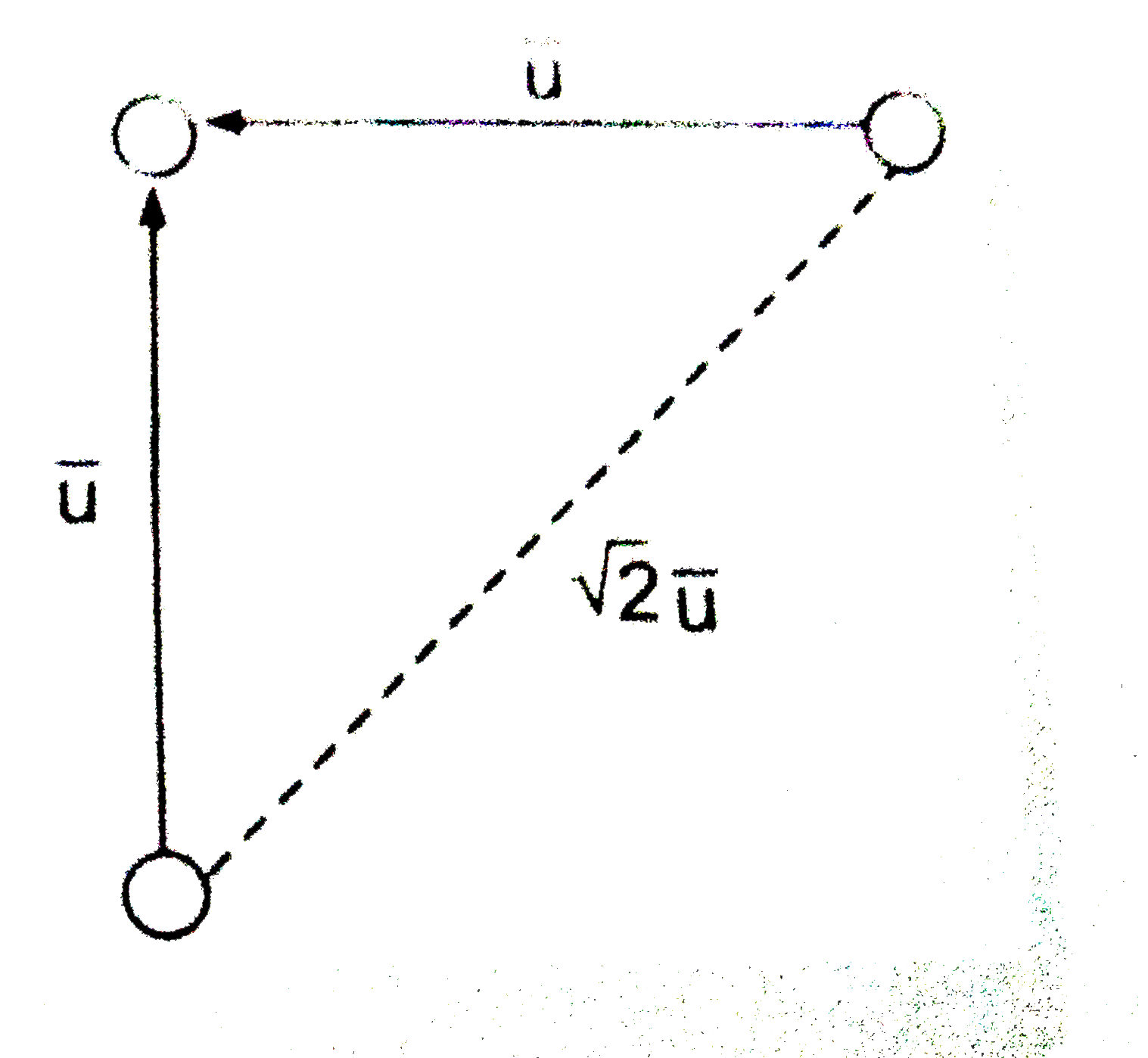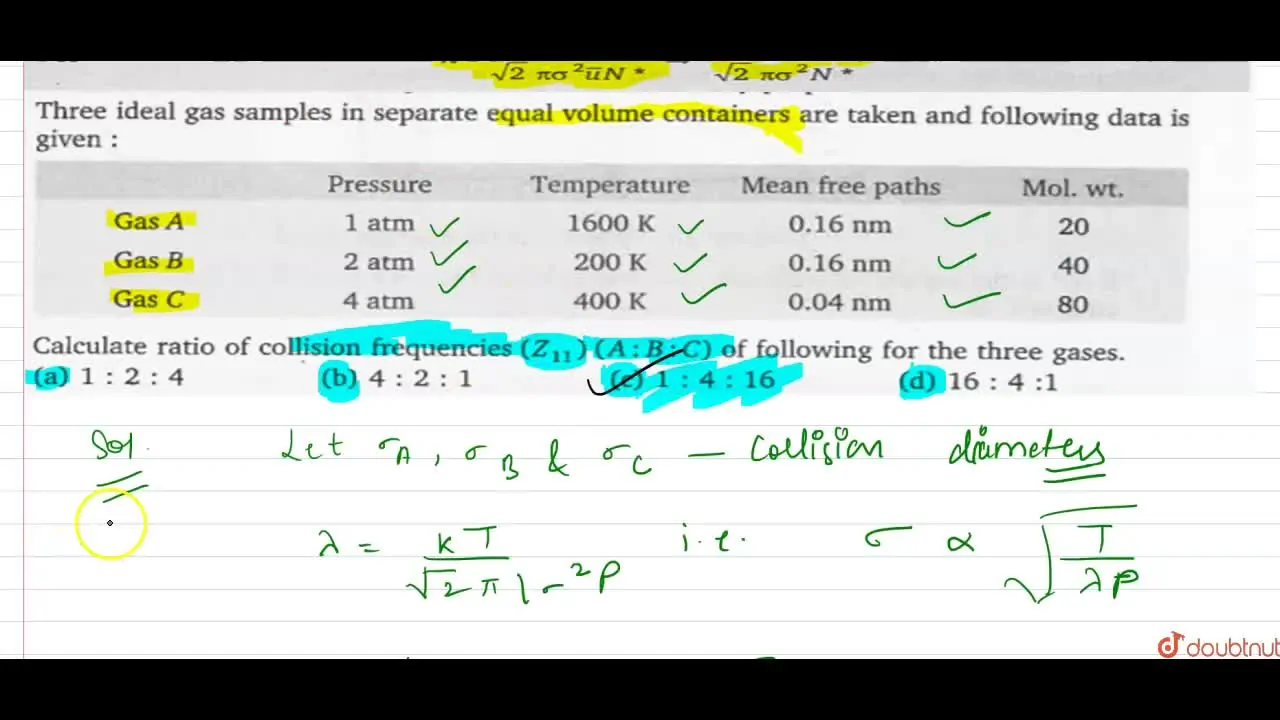Collision cross-section is an area of an imaginary sphere of radius around the molecule within which the centre of another molecule cannot penetrate.
The volume swept by a single molecule in unit time is

where is the average speed
If is the number of molecules per unit volume, then the number of molecules within the volume V is
Hence, the number of collision made by a single molecule in unit time will be
In order to account for the movements of all molecules, we must consider the average velocity along the line of centres of two coliding molecules instead of the average velocity of a single molecule . If it is assumed that, on an average, molecules collide while approaching each other perpendicularly, then the average velocity along their centres is as shown below.

Number of collision made by a single molecule with other molecule per unit time is given by
The total number of bimolecular collisions per unit volume per unit time is given by
If the collsion involve two unlike molecules then the number of collisions per unit volume per unit time is given as
where and are the number of molecules per unit volume of the two types of molecules, is the average diameter of the two molecules and is the reduced mass. The mean free path is the average distance travelled by a molecule between two successive collisions. We can express it as follows :
Three ideal gas samples in separate equal volume containers are taken and following data is given :
Calculate ratio of collision frequencies of following for the three gases.
The correct Answer is:c
(c) Let and be collision diameters of A,B and C
Related Playlists
- BOOK - NARENDRA AWASTHICHAPTER - GASEOUS STATEEXERCISE - Level 1 (Q.31 To Q.60)1videos
GASEOUS STATE
- BOOK - NARENDRA AWASTHICHAPTER - GASEOUS STATEEXERCISE - Level 1 (Q.121 To Q.150)1videos
GASEOUS STATE
- BOOK - NARENDRA AWASTHICHAPTER - ELECTROCHEMISTRYEXERCISE - Level 3 - Subjective Problems1videos
ELECTROCHEMISTRY
- BOOK - NARENDRA AWASTHICHAPTER - IONIC EEQUILIBRIUMEXERCISE - Exercise196videos
IONIC EEQUILIBRIUM
Similar Questions
Nitrogen forms several gaseous oxides. One of them has a density of 1.33 g/L measured 764 mmHg and 150∘C. Write the formula of the compound.
01:08View SolutionDimethyl ether decomposes as
CH3OCH3(g)→CH4(g)+CO(g)+H2(g)
When CH3OCH3(g) decomposes to 20% extent under certain conditions, what is the ratio of diffusion of pure CH3OCH3(g) with methane?01:08View SolutionA solution containing 1MXSO4(aq) and 1MYSO4(aq) is electrolysed. If conc. Of X2+ is 10−zM when deposition Y2+ and X2+ starts simultaneously, calculate the value of Z.
Given: 2.303RTF=0.06
E∘x2+|X=−0.12V,E∘Y2+|Y=−0.24V02:16View SolutionMorphine (C17H19NO3), Which is used medically to relieve to pain is a base. What is its conjugate acid?
View SolutionIf X is the total number of collisions that a gas molecule registers with other molecules per unit time under particular conditions, then what is the collision frequency of the gas containing N molecules per unit volume is ?
05:19View SolutionThe number of molecules per unit volume (n) of a gas is given by
05:07View SolutionIf X is the total number of collision which a gas molecule registers with others per unit time under particular condions, then the collision frequency of the gas containing N molecules per unit volume is
01:06View SolutionCollision cross-section is an area of an imaginary sphere of radius σ around the molecule within which the centre of another molecule cannot penetrate.
The volume swept by a single molecule in unit time is

V=(πσ2)¯u where ¯u is the average speed
If N∗ is the number of molecules per unit volume, then the number of molecules within the volume V is
N=VN∗=(πσ2¯u)N∗
Hence, the number of collision made by a single molecule in unit time will be
Z=N=(πσ2¯u)N∗
In order to account for the movements of all molecules, we must consider the average velocity along the line of centres of two coliding molecules instead of the average velocity of a single molecule . If it is assumed that, on an average, molecules collide while approaching each other perpendicularly, then the average velocity along their centres is √2¯u as shown below.

Number of collision made by a single molecule with other molecule per unit time is given by
Z1=πσ2(¯urel)N∗=√2πσ2¯uN∗
The total number of bimolecular collisions Z11 per unit volume per unit time is given by
Z11=12(Z1N∗)orZ11=12(√2πσ2¯uN∗)N∗=1√2πσ2¯uN∗2
If the collsion involve two unlike molecules then the number of collisions Z12 per unit volume per unit time is given as
Z12=πσ212(√8kTπμ)N1N2
where N1 and N2 are the number of molecules per unit volume of the two types of molecules, σ12 is the average diameter of the two molecules and μ is the reduced mass. The mean free path is the average distance travelled by a molecule between two successive collisions. We can express it as follows :
λ=Average distance travelled per unit timeNO. of collisions made by a single molecule per unit time=¯uZ1
or λ=¯u√2πσ2¯uN∗⇒1√2πσ2¯uN∗
For a given gas the mean free path at a particular pressure is :03:30View SolutionCollision cross-section is an area of an imaginary sphere of radius sigma around the molecule within which the centre of another molecule cannot penetrate. The volume swept by a single molecule in unit time is V=(pisigma^(2))overline(u) where overline(u) is the average speed If N^(**) is the number of molecules per unit volume, then the number of molecules within the volume V is N=VN^(**)=(pisigma^(2)overline(u))N^(**) Hence, the number of collision made by a single molecule in unit time will be Z=N=(pi sigma^(2)overline(u))N^(**) In order to account for the movements of all molecules, we must consider the average velocity along the line of centres of two coliding molecules instead of the average velocity of a single molecule . If it is assumed that, on an average, molecules collide while approaching each other perpendicularly, then the average velocity along their centres is sqrt(2)overline(u) as shown below. Number of collision made by a single molecule with other molecule per unit time is given by Z_(1)=pisigma^(2)(overline(u)_("rel"))N^(**)=sqrt(2) pisigma^(2)overline(2)N^(**) The total number of bimolecular collisions Z_(1) per unit volume per unit time is given by Z_(1)=(1)/(2)(Z_(1)N^(**))or Z_(11)=(1)/(2)(sqrt(2)pisigma^(2)overline(u)N^(**))N^(**)=(1)/(sqrt(2))pisigma^(2)overline(u)N^(**2) If the collsion involve two unlike molecules then the number of collisions Z_(12) per unit volume per unit time is given as Z_(12)= pisigma _(12)^(2)(sqrt((8kT)/(pimu)))N_(1)N_(2) where N_(1) and N_(2) are the number of molecules per unit volume of the two types of molecules, sigma_(12) is the average diameter of the two molecules and mu is the reduced mass. The mean free path is the average distance travelled by a molecule between two successive collisions. We can express it as follows : lambda=("Average distance travelled per unit time")/("NO. of collisions made by a single molecule per unit time")=(overline(u))/(Z_(1)) or" "lambda=(overline(u))/(sqrt(2)pisigma^(2)overline(u)N^(**))implies(1)/(sqrt(2)pisigma^(2)overline(u)N^(**)) Three ideal gas samples in separate equal volume containers are taken and following data is given : {:(" ","Pressure","Temperature","Mean free paths","Mol.wt."),("Gas A",1atm,1600K,0.16nm,20),("Gas B",2atm,200K,0.16nm,40),("Gas C",4atm,400K,0.04nm,80):} Calculate number of collision by one molecule per sec (Z_(1)) .
05:23View SolutionCollision cross-section is an area of an imaginary sphere of radius sigma around the molecule within which the centre of another molecule cannot penetrate. The volume swept by a single molecule in unit time is V=(pisigma^(2))overline(u) where overline(u) is the average speed If N^(**) is the number of molecules per unit volume, then the number of molecules within the volume V is N=VN^(**)=(pisigma^(2)overline(u))N^(**) Hence, the number of collision made by a single molecule in unit time will be Z=N=(pi sigma^(2)overline(u))N^(**) In order to account for the movements of all molecules, we must consider the average velocity along the line of centres of two coliding molecules instead of the average velocity of a single molecule . If it is assumed that, on an average, molecules collide while approaching each other perpendicularly, then the average velocity along their centres is sqrt(2)overline(u) as shown below. Number of collision made by a single molecule with other molecule per unit time is given by Z_(1)=pisigma^(2)(overline(u)_("rel"))N^(**)=sqrt(2) pisigma^(2)overline(u)N^(**) The total number of bimolecular collisions Z_(11) per unit volume per unit time is given by Z_(11)=(1)/(2)(Z_(1)N^(**))"or" Z_(11)=(1)/(2)(sqrt(2)pisigma^(2)overline(u)N^(**))N^(**)=(1)/(sqrt(2))pisigma^(2)overline(u)N^(**2) If the collsion involve two unlike molecules then the number of collisions Z_(12) per unit volume per unit time is given as Z_(12)= pisigma _(12)^(2)(sqrt((8kT)/(pimu)))N_(1)N_(2) where N_(1) and N_(2) are the number of molecules per unit volume of the two types of molecules, sigma_(12) is the average diameter of the two molecules and mu is the reduced mass. The mean free path is the average distance travelled by a molecule between two successive collisions. We can express it as follows : lambda=("Average distance travelled per unit time")/("NO. of collisions made by a single molecule per unit time")=(overline(u))/(Z_(1)) "or "lambda=(overline(u))/(sqrt(2)pisigma^(2)overline(u)N^(**))implies(1)/(sqrt(2)pisigma^(2)overline(u)N^(**)) Three ideal gas samples in separate equal volume containers are taken and following data is given : {:(" ","Pressure","Temperature","Mean free paths","Mol.wt."),("Gas A",1atm,1600K,0.16nm,20),("Gas B",2atm,200K,0.16nm,40),("Gas C",4atm,400K,0.04nm,80):} Calculate number of collision by one molecule per sec (Z_(1)) .
04:06View SolutionLet the vectors ¯u,¯v,¯¯¯w be coplanar, , then ¯u⋅(¯vׯ¯¯w)=
03:45View SolutionIf ¯u=ˆi−2ˆj+ˆk,¯v=3ˆi+ˆk,¯¯¯w=ˆj−ˆk, then (¯u+¯¯¯w)⋅((¯uׯv)×(¯vׯ¯¯w))=
01:34View SolutionIf ¯u,¯v,¯¯¯w are three non-coplanar vectors, then (¯u+¯v−¯¯¯w)⋅((¯u−¯v)×(¯v−¯¯¯w))=
02:22View Solutionयदि प्रति एकांक आयतन अणुओं की संख्या n है तो आदर्श गैस समीकरण लिखिए ।
05:00View SolutionAn ideal gas of N molecules occupies a volume V. The average kinetic energy per molecule is u . If P denotes the pressure of the gas, then
01:38View Solution


